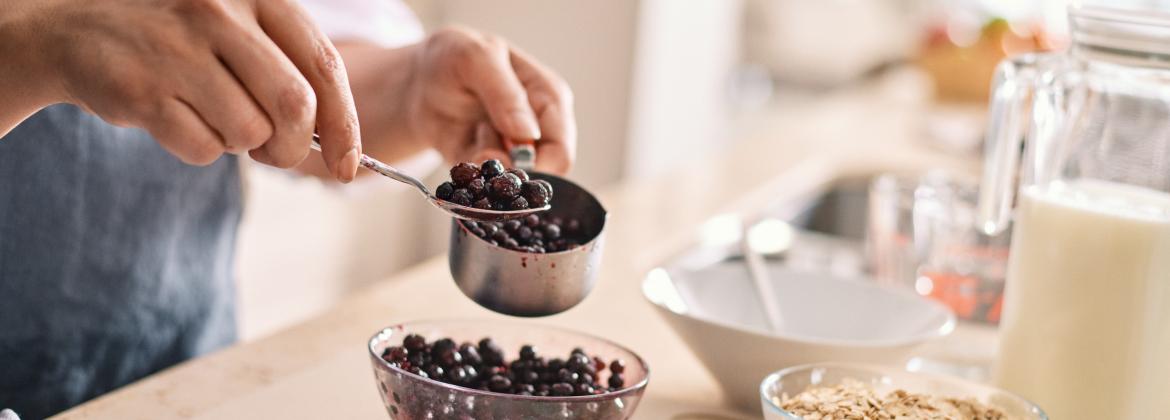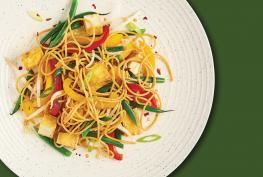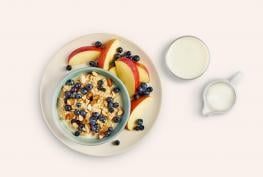Print or share this article
Knowing how to adjust recipes in a way that works for you is an important skill to help you eat healthily. Continue reading for tips on how you can personalize recipes based on your health needs, dietary restrictions, culture, budget and family needs.
On this page
Adjusting recipes for health
Ingredients can be reduced, added or replaced to make the recipes healthier. To do this, look at a recipe and identify what ingredients can be changed, and how. For example:
- Reduce sugar by decreasing the amount the recipe asks for.
- If a muffin recipe asks for 1 cup of sugar, try using 1/2 or 2/3 cup of sugar instead.
- If a recipe for salad dressing calls for sugar, try making it without any sugar.
- Replace saturated fat with healthy fats.
- If a recipe calls for coconut oil, palm oil or butter, use vegetable oil such as canola or olive oil instead.
- Reduce sodium.
- Rinse canned beans, chickpeas and peas.
- Choose broths that are lower in sodium.
- Add herbs and spices to recipes for flavour instead of adding salt.
- If a recipe calls for salt as well as ingredients that contain added sodium, consider if you really need to add extra salt.
- Add fibre.
- Vegetables or legumes can be added to almost any savoury dish for extra nutrients and fibre. Add vegetables to enchiladas, pasta sauce, stews and casseroles.
- Use whole grain flour instead of white flour in baked goods. Try adding ingredients with fibre such as flax seed or bran.
Adjusting recipes for dietary restrictions
You can modify recipes for specific diets, allergies or intolerances. To do this, identify the ingredients that need to be removed or replaced in order to meet the dietary restriction. For example:
- To make a recipe gluten-free, you can try using brown rice or buckwheat flour instead of wheat flour. The change in flour might alter the texture of a recipe, so you might need to adjust the amount of other ingredients.
- To make a recipe dairy-free, you can replace cow’s milk with an unsweetened fortified plant-based beverage. If cheese is an ingredient, recipes can often be made without it.
- To make a recipe nut-free, you can sometimes replace peanut butter with sunflower seed butter or tahini (sesame seed paste). For recipes that use nuts for an added crunch, try pumpkin seeds or roasted chickpeas instead.
- To make a recipe vegetarian, you can often replace the meat. Try tofu in a stir-fry instead of chicken, or lentils in a wrap instead of shredded pork.
Adjusting recipes to reflect culture
Cooking can reflect traditions and culture. For example:
- Try including your family’s traditions in a new recipe. This could mean:
- including wild game in a stew, or adding vegetables that are familiar to you, such as bok choy or cassava, to new dishes.
- using spices and herbs that you and your family enjoy to adjust the flavours of a recipe.
- If an ingredient you traditionally use in a recipe isn’t available, try modifying your recipe and see if there is a similar ingredient you could use instead.
Adjusting recipes to lower cost
Recipes can be adapted to use less costly ingredients. For example:
- Replace ingredients with lower cost alternatives or on-sale options. Try plant-based protein foods such as lentils, beans or chickpeas, or use barley instead of quinoa. These foods are often lower cost and can make a great meal.
- Use ingredients you already have at home or change a recipe to use ingredients that are on sale. If a casserole calls for cauliflower, and you already have broccoli at home, use it instead. If a recipe calls for pears, but apples are on sale, try the recipe using apples.
Adjusting recipes to meet your family’s needs
Some recipes may make too much or not enough food. Other times, the recipe calls for a specific kitchen tool that you might not have. Recipes can be adapted to suit your family’s needs and resources. For example:
- If you have a large family, you may want to double a recipe. Do this by multiplying the ingredient quantities by 2. There is often no need to double the amount of spices in a recipe. Instead, do a taste test before adding more. Also note that the cooking time will not need to be doubled, although it may need to be adjusted.
- If you are cooking for only 1 person, you may want to halve the amount you make. Do this by dividing the ingredient quantities by 2. However, making a full recipe could provide you with leftovers and save you time in the future.
- You can make most recipes with cooking tools that you have at home. If you don’t have a slow cooker, use a large pot. Mince garlic with a knife instead of using a garlic press. If you don’t have a zester, use a peeler and then cut the zest into small pieces.
Make a healthy choice
What you eat on a regular basis matters for your health.
- Choose foods that have little to no added sodium, sugars or saturated fat.
- Compare the nutrition facts table on foods to choose products that are lower in sodium, sugars or saturated fat.




